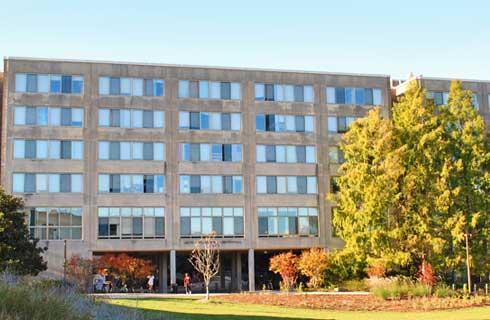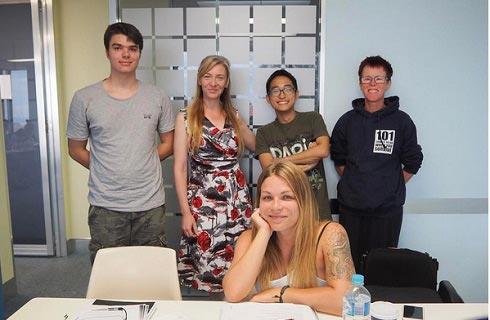- IDP China>
- 课程库>
- 工程与技术>
- 工程学及其相关技术>
- 土木工程>
- PhD Analytics to Interpret Acoustic Emission Generated by Geotechnical Infrastructure Assets
博士分析解释岩土基础设施资产产生的声发射
PhD Analytics to Interpret Acoustic Emission Generated by Geotechnical Infrastructure Assets

学历文凭
Ph.D.

专业院系
Mechanical, Electrical and Manufacturing Engineering

开学时间

课程时长

课程学费

国际学生入学条件
A relevant master's degree and / or experience in one or more of the following will be an advantage: artificial intelligence, computer science, signal analysis.
IELTS: Overall score of 6.5 with not less than 6.0 in each test.
TOEFL iBT: Overall score of 92, with not less than 22 in each test
IDP—雅思考试联合主办方

雅思考试总分
6.5
- 雅思总分:6.5
- 托福网考总分:92
- 托福笔试总分:160
- 其他语言考试:PTE- Overall score of 67, with not less than 63 in each sub-test
CRICOS代码:
申请截止日期: 请与IDP联系 以获取详细信息。
课程简介
Loughborough University is a top-ten rated university in England for research intensity (REF2014) and an outstanding 66% of the work of Loughborough's academic staff who were eligible to be submitted to the REF was judged as ‘world-leading' or ‘internationally excellent', compared to a national average figure of 43%. In choosing Loughborough for your research, you'll work alongside academics who are leaders in their field. You will benefit from comprehensive support and guidance from our Doctoral College, including tailored careers advice, to help you succeed in your research and future career. Proportions of the energy dissipated during deformation of particulate materials are converted to heat and sound. The high-frequency (10kHz) component of this sound energy is called acoustic emission (AE). AE monitoring offers the potential to sense particle-scale interactions that lead to macro-scale responses of granular materials. AE is widely used in many industries for non-destructive testing and evaluation of materials and systems, however, it is seldom used in geotechnical engineering, despite evidence of the benefits, because AE generated by particulate materials is highly complex and difficult to measure and interpret. The aim of this PhD is to develop analytics for the automated interpretation of AE generated by geotechnical infrastructure assets. The objectives are: (1) to establish feature extraction and/or pattern recognition methodologies to quantify AE parameters, (2) to develop artificial intelligence analytics to convert AE input parameters to asset health statuses, and (3) to assess performance of the analytics using experiments. Extensive datasets of AE measurements have been produced through series of controlled element (e.g. triaxial, direct-shear) and full-scale physical model (e.g. buried pipelines) tests. This PhD will exploit the existing datasets, and supplement them using new experiments. The successful candidate will join the ‘Listening to Infrastructure' research group, which is developing continuous, real-time acoustic emission (AE) monitoring systems that can be distributed across geotechnical infrastructure assets (e.g. buried pipelines, foundations, retaining structures) to sense soil and soil/structure interaction behaviour, and provide early warning that will enable targeted and timely interventions.
相关申请
 预科
预科 奖学金
奖学金 实习机会
实习机会 在校学习
在校学习 跨境学习
跨境学习 校园授课-线上开始
校园授课-线上开始 在线/远程学习
在线/远程学习
开学时间&学费
学费信息仅供参考,请与IDP联系以获取详细信息
| 开学时间 | 时长 | 学费 | 地点 |
|---|
学校排名

世界排名401
数据源:
泰晤士高等教育世界大学排名
关于拉夫堡大学

拉夫堡大学自1909年以来,作为继续教育和高等教育机构,拥有悠久的成功历史。如今,它是英国乃至世界领先的教育机构之一。该大学每年为成千上万的学生提供一流的教育和学习体验,并始终位列英国前十(《完全大学指南》,2017-2026)。拉夫堡大学的体育学科享誉全球,并被评为全球体育相关学科最佳大学(《QS世界大学学科排名》,2017-2025)。该大学以其各学科卓越的教学质量而自豪,并招募了一支多元化、多国籍的学术团队,确保学生接受由专业且经验丰富的教职员工提供的多样化教育。大学为包括工程、设计、商业等在内的所有学科领域提供卓越的设施。学校包容性的校园热烈欢迎国际学生,并提供广泛的支持设施,帮助他们在整个学习期间安顿下来并茁壮成长。大学设施齐全,致力于为学生提供卓越的学术体验和有趣的学生生活方式。学校拥有多元化的学生会、轻松的学习和社交空间以及全面的学生支持服务。大学的主校区位于东米德兰兹郡的拉夫堡镇。该校区交通便利,可轻松前往周边大城市,并为学生提供愉快的学习体验所需的一切。第二个校区位于伦敦伊丽莎白女王奥林匹克公园。拉夫堡大学的伦敦校区专为研究生学习和研究而设立。拉夫堡大学伦敦分校汇聚了具有影响力的思想领袖、先锋研究人员和富有创造力的创新者,为学生提供英国最优质的研究生学习体验之一。
本校相关课程

会前课程C
学历文凭
English Language
开学日期
课程费用总额


博士学位体育,运动与健康科学
学历文凭
Ph.D.
开学日期
课程费用总额


PhD International Relations, Politics and History
学历文凭
Ph.D.
开学日期
课程费用总额


物理学博士
学历文凭
Ph.D.
开学日期
课程费用总额


机械,电气与制造工程博士学位
学历文凭
Ph.D.
开学日期
课程费用总额


博士数学科学
学历文凭
Ph.D.
开学日期
课程费用总额

其他相关课程

Bachelor of Technology (Engineering) - Civil
 伊迪斯科文大学
伊迪斯科文大学学历文凭
Bachelor Degree
开学日期
课程费用总额


PhD in Transport Studies - Digital Futures
 利兹大学
利兹大学泰晤士高等教育世界大学排名:118
学历文凭
Ph.D.
开学日期
课程费用总额


工程学硕士-运输工程(MESTU-TRAN-T3MES)
 奥克兰大学
奥克兰大学学历文凭
Masters Degree (Taught and Research)
开学日期
课程费用总额


Bachelor of Engineering (Honours) / Bachelor of Science Conjoint - Civil Engineering
 奥克兰大学
奥克兰大学学历文凭
Dual (Conjoint) Degree
开学日期
课程费用总额


土木建筑设计高级文凭
 西澳大利亚州职业技术学院
西澳大利亚州职业技术学院学历文凭
Advanced Diploma
开学日期
课程费用总额


MPhil Civil Engineering
 伯明翰大学
伯明翰大学泰晤士高等教育世界大学排名:99
学历文凭
Masters Degree (Research)
开学日期
课程费用总额










